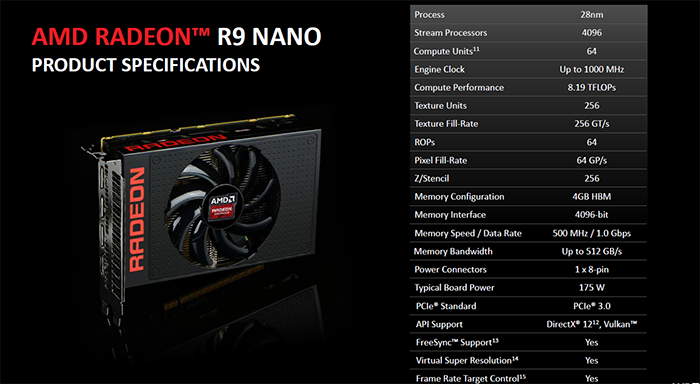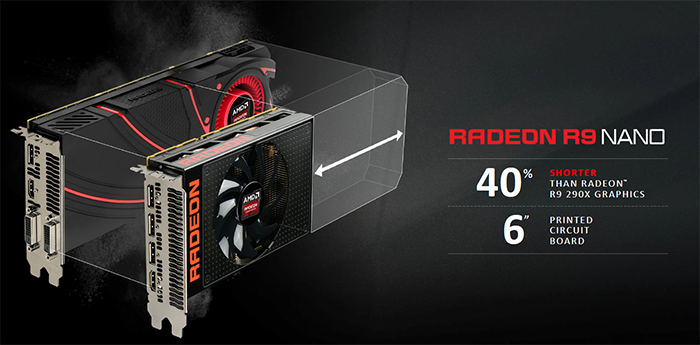AMD launched the premium Radeon R9 Fury X graphics card back in June this year. Designed to compete with the best consumer graphics Nvidia has to offer, Fury X uses a scaled-up GCN architecture and, for the first time, HBM memory for increased bandwidth and potential to build smaller cards.
And while the liquid-cooled Fury X puts AMD back in the big league as far as all-out performance is concerned it's not quite the GeForce-thrashing card that some expected. Of rather more interest to many is what AMD can do with the power efficiencies and massively reduced form factor of HBM memory, and AMD teased the appropriately named Nano a short while back.
Now, AMD, true to recent fashion of distilling morsels of information over time, is ready to share a few more details about the Nano ahead of its retail bow in September. The most important of these is the specification of the card, whose knowledge enables us to decipher its gaming potential.
Said spec sheet is illuminating insofar as the Nano version uses the full complement of Fiji cores available to the Fury X card. This is a surprise given that the Fury Pro model uses a cut-down version of the die, and we imagine the likes of Asus and Sapphire will not be best pleased at the arrival of a smaller, more efficient card that is potentially faster.
Not only does the R9 Nano feature a full-fat Fiji XT die, the core frequency, quoted as up to 1,000MHz is impressive for a 175W TDP. Further specification exposition is best handled by using a comparative table, so here we go.
Radeon R9 Fury X |
Radeon R9 Fury |
Radeon R9 Nano |
Radeon R9 390X |
|
| Launch date | June 2015 |
July 2015 |
September 2015 |
June 2015 |
| Codename | Fiji XT |
Fiji Pro |
Fiji XT |
Grenada XT |
| DX support | 12.0 |
12.0 |
12.0 |
12.0 |
| Process (nm) | 28 |
28 |
28 |
28 |
| Transistors (mn) | 8,900 |
8,900 |
8,900 |
6,200 |
| Approx Die Size (mm²) | 596 |
596 |
596 |
438 |
| Full implementation of die | Yes |
No |
Yes |
Yes |
| Processors | 4,096 |
3,584 |
4,096 |
2,816 |
| Texture Units | 256 |
224 |
256 |
176 |
| ROP Units | 64 |
64 |
64 |
64 |
| Peak GPU Clock/Boost (MHz) | 1,050 |
1,000 |
1,000 |
1,050 |
| Peak GFLOPS (SP) | 8,602 |
7,168 |
8,192 |
5,914 |
| Peak GFLOPS (DP) | 537 |
448 |
512 |
739 |
| Memory Clock (MHz) | 1,000 |
1,000 |
1,000 |
6,000 |
| Memory Bus (bits) | 4,096 |
4,096 |
4,096 |
512 |
| Max bandwidth (GB/s) | 512 |
512 |
512 |
384 |
| Default memory size (MB) | 4,096 |
4,096 |
4,096 |
8,192 |
| Memory type | HBM |
HBM |
HBM |
GDDR5 |
| Power Connectors | 8+8-pin |
8+8-pin |
8-pin |
8+6-pin |
| TDP (watts) | 275 |
275 |
175 |
275 |
| GFLOPS per watt | 31.28 |
26.06 |
46.81 |
21.50 |
| Current price (Newegg) | $649 |
$549 |
??? |
$429 |
Radeon R9 Nano is in fact very close to the performance of the Fury X card; the only meaningful difference, from a performance point of view, appears to be a slightly reduced core speed. The back-end of the GPU is the same so it's reasonable to assume that it should benchmark at approximately 95 per cent of the level exhibited by AMD's best-ever GPU
It bears repeating that AMD is able to shoehorn a sizeable amount of power into a card that consumes 175W TDP, or over one-third less than the liquid-cooled Fury X. AMD is picking the very best Fiji XT silicon, examining how it behaves when run at lower voltages, and then passing a select few for R9 Nano duties.
What's unknown is whether the Nano cards are able to mete out the peak 1,000MHz core frequency at all times, however, and we shall only know the answer to this minor riddle once we have a card on the test-bench. Given the meagre TDP for a high-end card, we imagine the R9 Nano's core will bounce along between 800MHz to 1,000MHz in most games. Lending credence to this thinking is the knowledge that the Nano is up to 30 per cent faster than an R9 290X, according to AMD, while the headline Fury X, in our benchmarks at least, is 40-50 per cent faster.
It's not just about speed, as AMD is keen to point out, as the 6in-long card fits into Mini ITX systems that are naturally too small for cards such as the R9 290/390X and rival high-performance GPUs from Nvidia. AMD also believes the Nano's speed is more than enough to handle the very best Mini ITX cards from Nvidia's stable, currently lead by the GTX 970 Mini.
R9 Nano makes most sense for gamers who want a small-form-factor system that has enough graphics horsepower to drive the latest games at tasty resolutions. On paper it's also a good candidate for a deluxe Steam Box for the living room, though the absence of HDMI 2.0 may scupper immediate interest for those of you looking to game on a 4K TV.
AMD is promising lots of performance in a tiny card, underscored by the R9 Nano using the full array of Fiji XT cores and lots of bandwidth. Does a Mini ITX card endowed with this level of muscle interest you, readers? We'd love to hear your thoughts.















